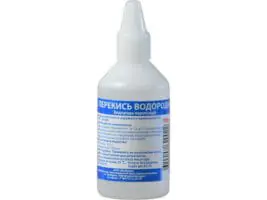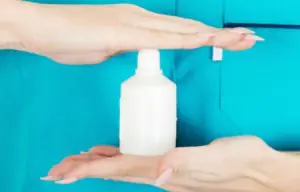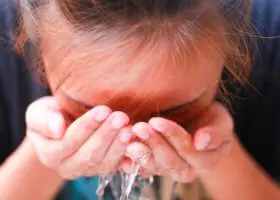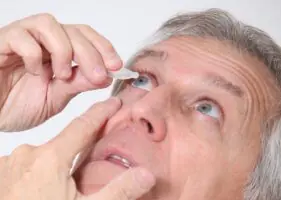Getting various substances into the eyes is a common everyday situation. Often people do not attach any importance to them, or, on the contrary, consider it very dangerous and begin to take decisive measures. How dangerous is it really if peroxide gets into your eye?
Is it possible to rinse and drip eyes with hydrogen peroxide?

Hydrogen peroxide has a powerful antiseptic effect - it destroys bacteria in the places it comes into contact with. Its action is based on the fact that the compound itself is unstable and easily breaks down into water and oxygen.
Excess oxygen has a detrimental effect on bacteria, but it is also unsafe for human tissue. Contact of peroxide with the mucous membrane of the eye can cause a violent chemical reaction and tissue burns.
Accidental ingestion of small amounts of peroxide is not dangerous to the eyes, but the introduction of large quantities of peroxide is harmful. Therefore, wiping the skin around the eyes, including the eyelids, with an antiseptic is acceptable. Eye drops for conjunctivitis can be taken with peroxide at a concentration of 0.5% and only as prescribed by a doctor.
Peroxide is included in solutions for cleaning lenses - it cleans them, removes protein deposits, and prevents the development of bacteria. But such solutions must be used strictly according to the instructions. The peroxide in them is in a concentration that does not harm the eyes.
What to do if peroxide gets into your eye
If undiluted topical peroxide gets into your eye, there is no need to be alarmed. The main thing to do is to rinse your eyes with running water. The less time the medicine comes into contact with the mucous membrane, the less harm it will cause.
Further actions depend on the condition of the eyes - if you feel only mild discomfort and slight redness, then no action needs to be taken. If pain and severe redness occur, you need to drip your eyes with Lidocaine or Levomycetin drops. These drugs relieve pain in the eye and speed up healing, preventing complications. If these steps do not help, you need to consult a doctor.
Is it dangerous
Accidental contact of peroxide with the eyes when wiping the skin of the face is not dangerous - it only causes an unpleasant burning sensation in the eye, but does not cause serious harm.
The danger comes from getting undiluted peroxide for external use in large quantities into the eye. But it’s better to play it safe and wash your eyes every time a suspicious substance gets into them.
In what cases is a burn possible?

A burn to the cornea of the eye is possible if peroxide comes into contact with a concentration of more than 3%. A weaker solution will cause severe discomfort, but is safe if you rinse your eyes in time.
The danger comes from dropping it into the eye, trying to rinse it with undiluted peroxide from a pharmacy, or carelessly wiping nearby areas of the skin.
Symptoms of a burn
You can distinguish a burn from a normal injury by the following signs:
- A burning sensation that is poorly relieved by painkillers;
- Redness of the eyes;
- lacrimation;
- Photophobia;
- Swelling of the eyelids;
- Loss of eyelashes;
- Deterioration of vision;
- Ulcers on the cornea.
If no action is taken, these symptoms will progress. To treat a chemical burn, you need to see an ophthalmologist.
Possible consequences and complications
The most common complications of a burn are infectious. Damaged tissues become convenient entry points for bacteria, and against the background of a burn, purulent inflammatory processes easily develop - conjunctivitis, blepharitis, keratitis, which can lead to the spread of infection further into the eyeball.
A long-term burn, even without inflammatory complications, can lead to the development of a cataract - an opaque area of the cornea that impairs vision or completely prevents the damaged eye from seeing.
How to avoid them
You can avoid complications by promptly seeking medical help. The doctor will prescribe eye drops with antibiotics and agents that accelerate corneal recovery.
This eliminates bacteria, prevents severe bacterial complications from developing and reduces the risk of cataract formation.
What to do if peroxide gets into your eye
Getting peroxide into the eye does not necessarily lead to the terrible consequences listed in the previous section. In most cases, this only causes severe discomfort, but is not too dangerous to health.
Therefore, the first thing to do when peroxide gets into your eye is to calm down. Fear is not the best helper; it can lead to rash actions.
First aid

Actions to take if undiluted peroxide gets into your eyes:
- Rinsing the eyes with running water (from the tap, but preferably boiled water);
- Instillation of anesthetic and disinfecting drops (Lidocaine, Visin, Levomycetin, artificial tears);
- You need to lie down with a clean napkin on the affected eye for 10-15 minutes.
These actions are effective in most cases of peroxide getting into the eyes, they are safe for the patient and allow you to get rid of unpleasant sensations. If this is not enough, pain occurs, the condition worsens, you need to consult a doctor.
Further treatment
First aid in most cases helps to cope with the consequences of peroxide getting into the eyes - after these actions the patient feels well. However, minor effects from a chemical burn can last for several hours.
The patient may feel discomfort, photophobia, and increased lacrimation. During this period, it is advisable to protect your eyes from bright light, exposure to caustic substances and visual stress.
If there is concern that an infection may have entered the eye, it is possible to re-use disinfectant drops. Painkillers can be used repeatedly if the mucous membrane of the eyes is highly sensitive and the pain does not go away quickly. If you need to use painkillers more than twice, or the condition worsens, you should consult a doctor.
In what cases is medical assistance needed?
Treatment by a doctor is necessary in cases where the actions described above were not enough to ensure good health or it was not possible to provide full first aid. Signs that you need to see a doctor:
- Getting a large amount of undiluted peroxide into the eyes;
- Inability to provide first aid to the victim in a timely manner;
- Discomfort in the eyes does not go away, despite the measures taken;
- There could be an infection in the eye;
- The patient has recently suffered an eye injury or conjunctival injury;
- Signs of a purulent infection appeared.
In this case, the patient should be transported to an ophthalmology clinic. It is necessary to ensure sterile conditions - there should be no infection in the eye, so it must be covered with a sterile bandage or clean cloth. If the patient's condition does not allow him to get to the hospital on his own, you should call an ambulance.
Treatment
Long-term treatment for such conditions is usually not required. In a hospital setting, the patient’s eyes are additionally washed with sterile solutions to eliminate damaging factors, a course of medications is prescribed, and if necessary, they are left for a while under the supervision of a doctor.
If complications arise, they also need to be dealt with, following the doctor’s recommendations.
Folk
Folk remedies will help relieve irritation and improve the patient’s well-being after peroxide gets into the eye. It is advisable to use them only as prescribed by a doctor as an additional treatment, but they are not suitable as a primary treatment.
To relieve swelling of the eyelids, you can make a compress with sea buckthorn oil. To do this, lubricate a clean napkin with oil and apply it to the closed eye. With such a compress you can do household chores, but it is better to lie down for 10-15 minutes. It can be done 3-4 times a day to relieve swelling of the eyelids.
Compresses and rinses with chamomile help get rid of itching and irritation, speed up the healing of the mucous membrane and prevent bacterial complications from developing. An aqueous infusion of chamomile is used, which is used morning and evening.
If drug treatment is prescribed, first wash the eyes with chamomile, then administer medications (so that the decoction does not reduce their effectiveness). Instead of chamomile, you can use clover, birch buds, and oak bark. Do not use alcohol tinctures - they irritate the eyes and aggravate the burn.
Medication

The doctor will prescribe a course of treatment, which depends on the degree of eye damage. For preventive purposes, a combination of an antiseptic (Sulfacyl sodium, Okomistin, Albucid) and a drug for corneal healing (Balarpan) in the form of eye drops is prescribed. The course of treatment is a week. Medicines can avoid bacterial complications and speed up the healing process.
If signs of a bacterial infection appear, drugs with antibacterial action are prescribed - Ofloxacin, Tobramycin, Tsipromed. They fight bacteria, prevent their spread and treat inflammatory processes. Eye antiseptics are used together with them - they increase the effectiveness of antibacterial agents, and means for restoring the cornea - this reduces the chance of its clouding.
Severe complications are treated promptly. If a cataract has formed, it is impossible to cope with it and restore full vision.
Features of treatment if peroxide gets into a child’s eye
The peculiarity of childhood trauma is that the baby is unlikely to realize that he is violating safety precautions, so peroxide can get into his eyes in large quantities, and parents will not notice it immediately, so the consequences can be very dangerous.
The procedure for parents is the same - rinse the eyes, apply pain-relieving drops, let the baby lie down, and protect the cornea from bright light and aggressive substances during the entire recovery period. You should consult a doctor in the same cases as in adults, and also if you do not know what substance got into your eye.
To avoid such situations, you should store aggressive liquids, including peroxide, in locked cabinets so that the child cannot use them. All hygiene procedures that require wiping the face with peroxide should only occur under the supervision of adults.
Watch a video on how to properly rinse your eyes:



